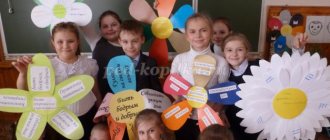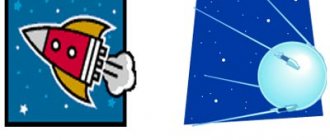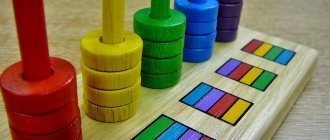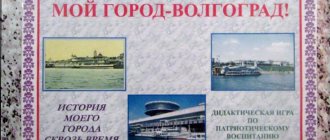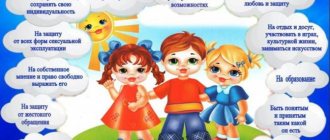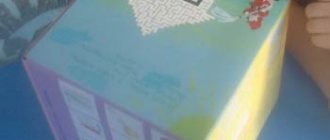"Find dangerous objects"
The game forms and reinforces ideas about everyday objects that pose a danger to health and life. Kindergarten students learn to identify dangerous things and use them correctly.
The game expands vocabulary, develops speech skills and logical thinking, and teaches the basics of proper behavior at home.
For the lesson, you need to cut out a large flower from paper, on each of the petals of which there is a picture of a dangerous domestic incident (cut, poisoned, burned by flame, etc.). You also need to prepare paper circles depicting things that correspond to dangerous cases (knife, chemical, gas stove on, etc.).
The teacher lays out the mugs, asks the students to place them correctly on the petals, explain the choice, and tell why the chosen item is dangerous.
Didactic game “Say it in one word”
You can play with one child or a group of children. The educational activity is suitable for preschoolers 5 years old and older; it can also be used in the first grade of school.
The goal of the didactic game “Name it in one word” is to consolidate the skill of classifying objects.
Tasks:
- developing the skill of classifying objects in the surrounding world;
- expansion of an individual dictionary on several topics at once;
- learning the ability to think, explain, unite;
- broadening one's horizons, developing curiosity and interest in the game form of learning;
- improvement of visual and auditory perception, memory, speech skills;
- developing the ability to concentrate, think logically, and think;
- fostering perseverance, correct behavior, and the ability to work productively in a team.
"Find identical objects"
For an activity that develops concentration, you need cards depicting several objects, including two or more identical ones. The child’s task is to find identical ones.
Game options
The simplest version of the lesson is for the teacher to show a card, and the student names the illustrated object. For example: “Who is drawn here?” - “Crow”, “Swallow”, “Tit”, “Crane”, “Bullfinch”, “Cuckoo” - “Name what you drew in one word?” - "Birds". Or: “What is drawn here?” - “Boletus”, “Chanterelles”, “Honey mushrooms”, “Boletus”, “Volnushka”, “Green milk” - “And together is this?” - "Mushrooms".
For the didactic game “Name 1 word”, you can make cards in the following categories:
- pets;
- forest animals;
- birds of our region;
- insects;
- river fish;
- Marine life;
- fruits;
- flowers;
- edible mushrooms;
- vegetables;
- berries;
- trees;
- transport;
- Kids toys;
- cookware;
- furniture;
- food products;
- sports accessories;
- school supplies;
- wardrobe;
- musical instruments;
- household tools.
You can organize a team game. Have the students divide into two groups. The teacher shows cards to groups of players in random order. Children must list the objects and give them a common name. The team with the most correct answers wins.
When playing with cards, you can combine objects not only by general properties, but also by color, edibility or inedibility, living or inanimate state.
You can also make a fun puzzle game. For it, you need to cut out pictures of such a shape that images of the same category are combined into a single canvas. The players' task is to correctly put together puzzles, name the objects depicted and the concept that unites them.
Complicating the rules
Another version of the game is when the leader asks the children leading questions. They can relate to completely different characteristics of objects:
- What is this?
- What is the shape of the object, its color, filling, smell, taste?
- What is this thing for, do people use it at home, at work and for what purpose?
You can also provide participants with a certain number of objects or their images and invite them to sort them according to a certain criterion - color, shape, purpose. By setting a time barrier for sorting, the presenter will make the game more dynamic and exciting.
